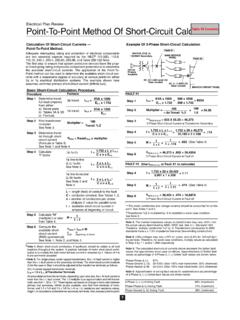Transcription of Chapter 2 Field crop classification
1 8 Dr. Sedhom Asaad, Agronomy Department, Faculty of Agriculture, Benha University (Principles of Agronomy) Chapter 2 Field crop classification It is well known that there are more than 600 cultivated plant species, From which there are about 100- 200 species play important role in the world trade. However, only fifteen plant species represent the most important economic crops. Therefore, these crop species must be classified or grouped in a convenient way to facilitate communication, dissemination and retrieval of scientific information as well as promotes the conservation, and improvement of certain plants. Generally, classification of these species is important for these reasons: 1. To get acquainted with crops. 2. To understand the requirement of soil & water different crops.
2 3. To know adaptability of crops. 4. To know the growing habit of crops. 5. To understand climatic requirement of different crops. 6. To know the economic produce of the crop plant & its use. 7. To know the growing season of the crop 8. Overall to know the actual condition required to the cultivation of plant. The grown Field crops are classified according to different stand points as follows: 1- Botanical classification . 2- Agronomic classification 3- Special- purpose classification . 4- classification according to life span. 5- classification according to root depth. 6- classification according to growth habit. 9 Dr. Sedhom Asaad, Agronomy Department, Faculty of Agriculture, Benha University (Principles of Agronomy) 7- classification according to Co2 fixation.
3 8- classification according to mode of pollinations. We will discuss these classifications briefly as follows: 1- Botanical classification Botanical classification is based upon similarity of plant parts and flower structure. This is the most important way of classification because it determines to what extent the plants are relatives. Field crops belong to the spermatophyte , or seed plant, division of plant kingdom , which includes plants reproduced by seeds. Within this division, the common crop plants belong to the subdivision of Angiosperm , which are characterized by producing seeds with coats (covered seed). The angiosperm , are then divided into two classes, namely, monocotyledons and the dicotyledons.
4 All the grasses, which include the cereals and sugar cane are monocotyledons. The legumes and other plants except the grasses are classified as dicotyledons. Each of these two classes is still further divided into orders, familes, genera, species and varieties. For example, maize crop (corn) which is monocotyledons belongs to the order herbaceous ; family Gramineae ; genus Zea; species mays; varieties; 10 as follows: 10 Dr. Sedhom Asaad, Agronomy Department, Faculty of Agriculture, Benha University (Principles of Agronomy) Plant Kingdom Division Spermatophyte Subdivision Angiosperms Class monocotyledons Order Herbaceous Family Gramineae Genus Zea Species mays Variety 10 The scientific name of maize crop is Zea mays, L.
5 Single cross ( ) 10 is a variety of maize. Note that each crop has distinct scientific name. Also, Field bean crop belongs to the family leguminosae: genus: Vicia; species: faba; variety: Giza 402 as follows: Plant Kingdom Division Spermatophyte Subdivision Angiosperms Class dicotyledons Order Herbaceous Family Leguminosae Genus Vicia Species faba Variety Giza 402 The scientific name of Field bean is Vicia faba, L. 11 Dr. Sedhom Asaad, Agronomy Department, Faculty of Agriculture, Benha University (Principles of Agronomy) Binomial system Each crop plant has two names; the genus and the species. The genus starts with capital letter, whereas the species name is small. The name of the man who first gave the accepted name is indicated by a letter or abbreviation.
6 For example, the scientific name of wheat is Triticum aestivum L. The letter L. signifies that the Swedish botanist Carl Linnaeus name dit. Sometimes a crop can be renamed by another scientist. Therefore, the crop name is followed by the initial of the first person (between bracts) followed by the initial of the second scientist as in soybean. The scientific name of this crop is Glycine max (L), Merr. The scientific name must be underlined or italic to be differentiated from any other words. Crop Plant Families: According to the botanical classification we can summarize the families of the most important Field crops as follows: 1- Monocotyledons: - Gramineae: includes the following crops: wheat, barley, rice, maize, oat, sugar cane, sorghum, rye grass, and sudan grass.
7 - Liliaceae: includes onion and garlic. 2- Dicotyledons: - Leguminosae: includes: Field bean, lupine, check pea, lentil, fenugreek, Egyptian clover, alfalfa, soybean, peanut, grass pea, caster bean, red clover and white clover. - Malvaceae: includes: cotton. - Linaceae: includes: flax. 12 Dr. Sedhom Asaad, Agronomy Department, Faculty of Agriculture, Benha University (Principles of Agronomy) - Solanceae: includes: potato, tomato, and tobacco. - Pedaliaceae: includes: sesame. - Composite: includes: sunflower, and safflower. Herein, a list with the scientific names for the most important Field crops: English name Scientific name Wheat Triticum aestivum L. Barley Hordium vulgare L. Rice Oryza ativa L.
8 Maize, Corn Zea mays L. Sorghum Sorghum bicolor (L.), Moench Sugar cane Saccharium officinarium L. Egyptian Millet Pennisetum typhoides L. Oats Avena sativa L. Rye Secale cerale L. Faba bean Vicia faba L. Egyptian Clover Trifolium alexandrinum L. Alfalfa Medicago sativa L. Fenugreek Trigonella foenum-groecum Cow pea Vigna sinesis L. Grass pea Lathyrus sativus L. Chick peas Cicer arietinum L. Egyptian lupin Lupins termis L. Soy bean Glycine max (L.), Merr. Peanut Arachis hypogaea L. Cotton Gossypium barbadense L. Flax Linum usitissimum L. Hemp Hibiscus cannabinus L.
9 13 Dr. Sedhom Asaad, Agronomy Department, Faculty of Agriculture, Benha University (Principles of Agronomy) Jute Corchorus sp. Sisal Agava sisalana Perrive Ramie Boehmeria nivea L. Sesame Sesamum indicum L. Caster bean Ricinus communis L. Sunflower Helianthus annus L. Safflower Carthamus tinctorius L. Sugar beet Beta vulgaris L. Foder beet Beta vulgaris L. Tobacco Nicottiana tabacum L. It is well known that the most important Field crop families belong o two botanical families, the grass family (gramineae) and the legume family (Legumioseae). Therefore, we have to get an idea about the characteristics of both families. Characteristics of grass family: This family includes about three fourths of the cultivated forage crops and all the cereals.
10 They have the following characters: - They are winter annuals or perennials. - They are almost herbaceous plants. - Stems are usually hollow, cylindrical and made up of nodes and internodes. - Leaves are alternative with parallel veins. The basal portions of the leaf sheath, encloses the stem, the sheath being open on the side opposite the blade. Where the blade of the leaf joins the sheath, there is usually found a peculiar appendage known as the ligule . 14 Dr. Sedhom Asaad, Agronomy Department, Faculty of Agriculture, Benha University (Principles of Agronomy) - The roots are fibrous and new roots are formed each year. - The flowers are perfect and collected in inflorescence at the top of plant.









